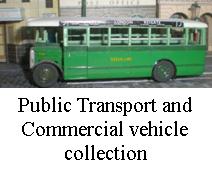This model is an historically important addition to our steam vehicle collection, joining our models of Cugnot’s steam tractor of 1769, Stephenson’s 1829 ‘Rocket’ steam locomotive, the 1888 De Dion steam car and a 1909 Stanley Steamer car.
In 1833 Hancock’s steam omnibus, the “Enterprise” (built for the London and Paddington Steam Carriage Company) began a regular service between London Wall and Paddington via Islington. It was the first regular steam carriage service, and was the first mechanically propelled vehicle specially designed for bus work to be operated. The service was brought to an end due to a dispute between Hancock and the operators, and Hancock himself built and operated further steam buses between 1833 and 1840.
The "Enterprise" had several features which, by contemporary standards, were innovatory. The engine was suspended on leaf springs along with the body of the vehicle, and the axle located with swinging arms with power being transmitted to the axle using chain drive. The rear axle also drove a fan which forced air into the firebox.
The "Enterprise" required three operators. The driver sat at the front and was responsible for steering and controlling the speed via an over-head regulator lever. A second operator occupied a small compartment to the rear of the vehicle between the boiler and the saloon; this man was responsible for looking after the boiler's water level and selecting reverse gear when required and could also over-ride the drivers regulator selection if he thought the driver was becoming too adventurous.. The third man stood on a platform at the rear and was responsible for maintaining the fire and braking, which was carried out by means of a large lever which acted directly on one of the rear wheels. Nothing is known about how these three men communicated.
Beneath the passenger seats are the water tanks containing about one ton of water giving a range of 10 to 20 miles before they needed replenishing. Top speed was about 25 mph (40 km/hr) but 12 mph (19 km/hr) was a more usual cruising speed. The weight of the original vehicle is not known but Tom Brogden’s replica (see illust. 001) built from the original drawings, weighs 3.2 tonnes.
Bearing in mind all the preceding factors it could possibly be argued that parliaments ‘Red Flag Act’ could in fact have had some merit after all. It could also be said that the man walking out in front with the red flag was exceedingly brave!
Later improvements included a ‘disc brake’ mounted on the crankshaft and automatic refuelling from the fuel bunkers by chutes direct to the furnace. Our model includes this feature although it still retains the Firemans platform.
When driving in 1833 Walter Hancock's arms became very painful when holding the steering wheel because of the rough roads. He invented a device that would lock the steering with a foot lever, to be used on straight sections of road and released to turn corners. Therefore it is suggested that Walter Hancock invented the worlds first automobile cruise control.

1/24th scale model.
Scratch built by Rod.

Rod built this model from scratch in 2013. It is all from plastic card, rod and tube. Painted with Halfords acrylic car paints and Humbrol enamels and acrylics it is the first models Rod has built incorporating metalising powders for some of the metal work.
A build album showing how Rod made this model can be found on our 'Facebook' page.
RETURN TO THE :-

